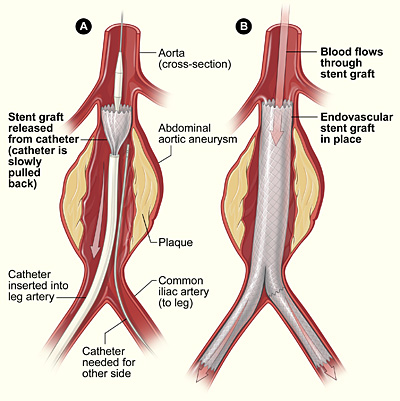
Minimally invasive procedure
Minimally invasive procedures (also known as minimally invasive surgeries) encompass surgical techniques that limit the size of incisions needed, thereby reducing wound healing time, associated pain, and risk of infection. Surgery by definition is invasive, and many operations requiring incisions of some size are referred to as open surgery. Incisions made during open surgery can sometimes leave large wounds that may be painful and take a long time to heal. Advancements in medical technologies have enabled the development and regular use of minimally invasive procedures. For example, endovascular aneurysm repair, a minimally invasive surgery, has become the most common method of repairing abdominal aortic aneurysms in the US as of 2003. The procedure involves much smaller incisions than the corresponding open surgery procedure of open aortic surgery.[1]
"Invasiveness" and "Invasive (medical)" redirect here. For "invasive" as related to abnormal tissue growth, see Cancer. For other uses, see Invasive (disambiguation).
Interventional radiologists were the forerunners of minimally invasive procedures. Using imaging techniques, radiologists were able to direct interventional instruments through the body by way of catheters instead of the large incisions needed in traditional surgery. As a result, many conditions once requiring surgery can now be treated non-surgically.[2]
Diagnostic techniques that do not involve incisions, puncturing the skin, or the introduction of foreign objects or materials into the body are known as non-invasive procedures.[3] Several treatment procedures are classified as non-invasive. A major example of a non-invasive alternative treatment to surgery is radiation therapy, also called radiotherapy.[4]
Equipment[edit]
Special medical equipment may be used, such as fiber optic cables, miniature video cameras and special surgical instruments handled via tubes inserted into the body through small openings in its surface. The images of the interior of the body are transmitted to an external video monitor and the surgeon has the possibility of making a diagnosis, visually identifying internal features and acting surgically on them.[8]
Benefits[edit]
Minimally invasive surgery should have less operative trauma, other complications and adverse effects than an equivalent open surgery. It may be more or less expensive (for dental implants, a minimally invasive method reduces the cost of installed implants and shortens the implant-prosthetic rehabilitation time with four–six months[9]). Operative time is longer, but hospitalization time is shorter. It causes less pain and scarring, speeds recovery, and reduces the incidence of post-surgical complications, such as adhesions and wound rupture. Some studies have compared heart surgery.[10]
Risks[edit]
Risks and complications of minimally invasive procedures are the same as for any other surgical operation, among the risks are: death, bleeding, infection, organ injury, and thromboembolic disease.[11]
There may be an increased risk of hypothermia and peritoneal trauma due to increased exposure to cold, dry gases during insufflation. The use of surgical humidification therapy, which is the use of heated and humidified CO2 for insufflation, may reduce this risk.[12]